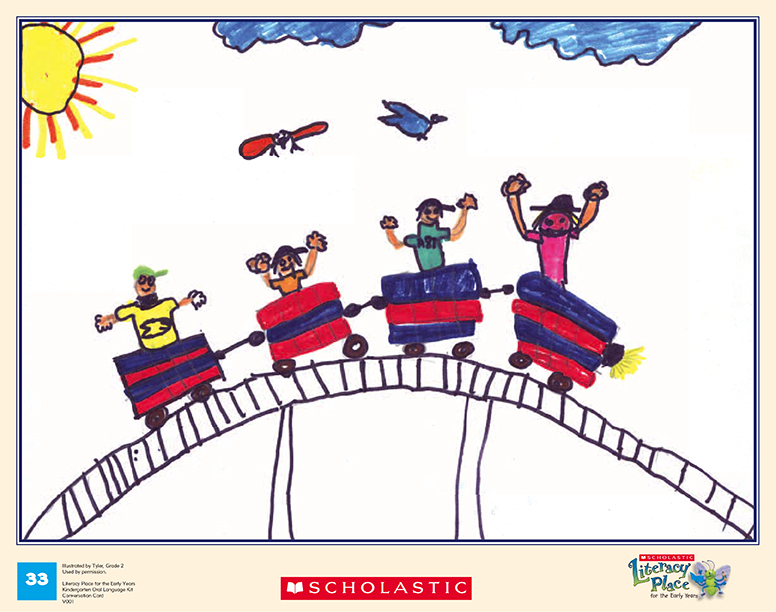Oral Language Teaching Strategy:
Extend and Check the Meaning Expand on the language and details in students’ communication to check the meaning.
Reference: Expand on the language and details in students’ communication to check the meaning.
Time: one 30-minute lesson or two 15-minute lessons
Materials: Art Card #33
Grouping: whole class or small group
Assessment:
Kindergarten Oral Language Assessment Scale
FOCUSING ON THE PICTURE
[Analyzing/inferring]- Show students the picture. Ask them to look at it and think about what they see and what they think is happening.
- Invite students to share their ideas about the picture with a partner.
- Provide partner discussion and then invite a few partners to share their thinking with the group.
The artist has painted a picture for us. What do you see in the picture? What do you think is happening?
We do not know exactly what is happening but it’s okay to make suggestions of different things that make sense and fit with the picture.
- Offer prompts to stimulate discussion:
- Who are the people in the picture?
- How many people are there?
- What do you think they are doing?
- What are they riding on? Why do you think this?
- Where is this happening?
How can you tell? What do you see that tells you this?
You have told me that you would like to be on the roller coaster in the car that has four red and blue stripes. Do you mean the car with the curved red and blue stripes or the car with the rectangular red and blue stripes?
GOING DEEPER
[Inferring/evaluating]- Offer prompts that focus the students on the emotions and interaction portrayed:
- How do you think these people are feeling? How can you tell?
- Which is the front car? How do you know?
- Why do you think they have their hands up?
- What do you think they may be saying? How will they be saying that? (e.g., soft voice, loudly, screaming, whispering, happily, sadly)
Why do you think this? - What do you think the artist was feeling when he/she created this?
- What do you think the artist was telling us?
- What do the colours tell us?
You may conclude the lesson at this point and do the second part on the next day, or you may decide to continue and do Connecting and Predicting as part of the first lesson.
CONNECTING
Teaching Tip: If you decide to do Connecting and Predicting on the second day, begin your lesson by reviewing the picture with the students.
[Making connections]- Ask students to connect their personal experiences with the emotions and interactions in the picture. Prompts might include:
- What do you think of when you look at the picture? Why?
- Does this remind you of anything?
- Have you ever been on a roller coaster? Where? When? Was it outside or inside?
- Who was with you on the ride?
- How did you feel as you were riding?
- How are you feeling about the picture?
- What do you like about it? Is there anything that you do not like?
- Offer specific prompts that fit the discussions you have had with the group.
Have you ever ridden on a roller coaster? Where was this? How did you feel when you were waiting in line to go on? How did you feel when you were on the ride? Did you want to go on the ride again?
PREDICTING
[Predicting]- Ask students to think about what might happen after the scene in the picture.
- The group could choose one possibility and in partners talk about what would be in that picture.
What do you think will happen next? Are they just about at the end of the ride? What will happen? Why do you think that?
LESSON EXTENSIONS
-
Use the picture as the basis for a shared writing lesson. Collect ideas from the students and collaborate on building 2 to 3 sentences about the picture.
-
Use the shared writing account as a shared reading text to reread with the students.
FOLLOW-UP IN CENTRES
-
Suggest that students discuss their thoughts about the picture with a partner during centre time. They may wish to draw or paint a picture showing what happens to the children on the roller coaster after this picture.
-
Encourage pairs of students to discuss other pictures or art work in their classroom. They can discuss what they see, what they think is happening, and what they think may happen next. Encourage students to tell how they feel when they look at the picture and what they liked or did not like about it.
-
Students may wish to use one of the puppets to represent the children on the roller coaster and retell the story that they think is happening in the picture.

